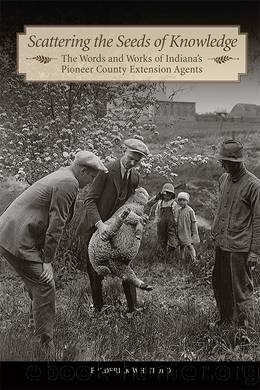Scattering the Seeds of Knowledge by Whitford Frederick;

Author:Whitford, Frederick;
Language: eng
Format: epub
Publisher: Purdue University Press
Farmers in Brown County had to go fifteen to twenty miles one way to shovel lime into a wagon and then make the return trip. Considering a wagon pulled by horses held approximately one ton of lime, it would take numerous trips to get enough to apply two tons per acre. Even the Ford truck used during the 1920s could only handle two to three tons at a time.81 Unless the farm was near the railroad station, long distances and poor roads made it quite difficult to get enough lime to do more than a few acres each year.82
A farmer with fields next to a railroad line might get the railroad to stop next to the farm for unloading. One agent noted, âThe convenience of having the lime brought as near the farm as possible by the railroad and permission was granted to leave the lime on the railroad right of way until it was convenient for the farmer to haul it, remained a considerable saving and proved to be a great inducement for farmers to order lime in this way.â83 In 1923, it cost $1.50 to $2.75 per ton to lay down the lime near the farm.84 According to Vermillion County agent Oral Riggs, farmers incurred a charge of $7 per hour âby the railroad for time the train was stopped while the stone was being dumped, but a saving of from two to five miles in the haul was greater than the charge by the railroad.â85
Since farmers were obligated to provide two men per car to unload the lime, they worked together to supply the labor.86 In 1928, Riggs reported, âA coach accompanied the train for the farmers to ride in from one unloading point to another.â87
Freight rates charged by the railroads determined the amount of lime purchased in any given year.88 Typically lime from the railroad fluctuated from $1.50 to $3 per ton.89 However, the cost of transportation to the farm doubled or tripled the final cost.90
In 1919, the Kosciusko County agent reported, âThe cost of hauling and distributing is a big drawback to the use of limestone,â but he hoped âfarmers will realize that the cost of handling and distributing will be much more than made up in increased crop yields.â91 In 1921, higher freight charges prompted the Daviess County agent to observe that âthe use of limestone this year was almost prohibitive.â92 And in 1924, the Jackson County agent stated, âWhile our demonstrations have shown that limestone at any price within reason is a good investment, it is hard to convince the man who is âhard-upâ that he can afford to pay $2.50 a ton for agricultural limestone after having bought it several years ago for $1.80.â93
Agents and Farm Bureau leaders worked to reduce the cost of purchasing and transporting limestone. In 1923, the agent in Morgan County got a â50 cents per ton reduction on stone trucked away from the quarry to go into parts of the county which are not reached by railroads and are seriously in need of limestone.
Download
This site does not store any files on its server. We only index and link to content provided by other sites. Please contact the content providers to delete copyright contents if any and email us, we'll remove relevant links or contents immediately.
Advocates of Reform by Unknown(45)
The Tractor Factor: The World's Rarest Classic Farm Tractors by Robert N. Pripps; Ralph Sanders; Andrew Morland(43)
Scattering the Seeds of Knowledge by Whitford Frederick;(33)
Drying and storage of agricultural crops by Carl W. Hall(1)
